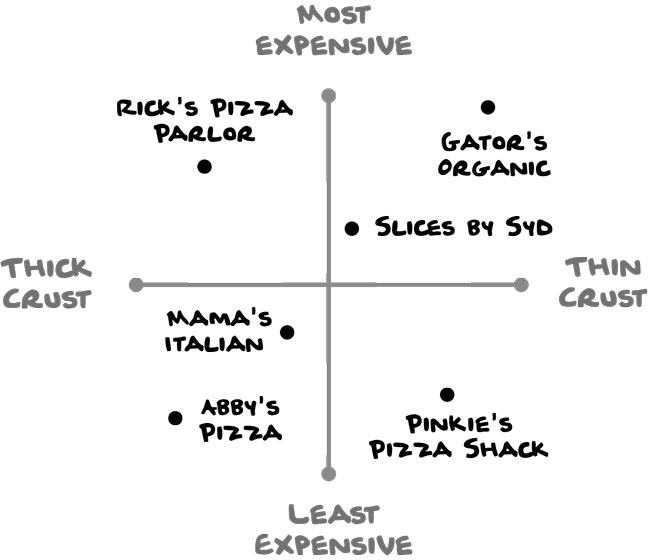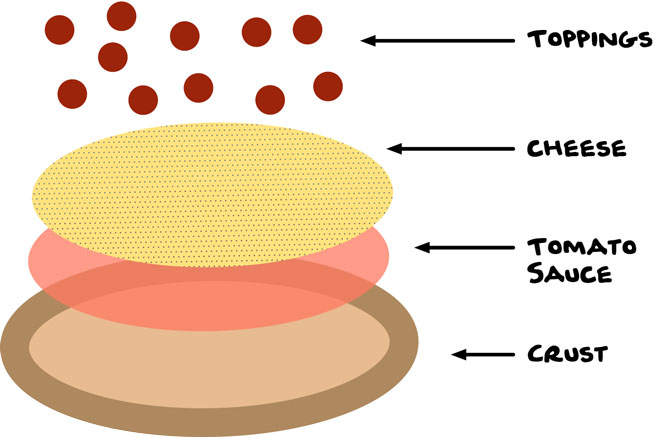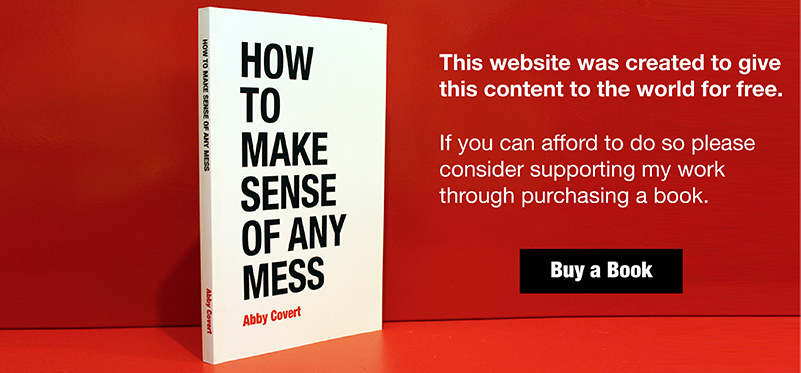Ambiguous (adjective.)
Definition: Open to interpretation.
Also referenced as: Ambiguity (noun)
Related to: Assumption, Classification, Exact, Label, Language
Chapter 3: Face Reality | Page 69
4. Quadrant Diagram
A quadrant diagram illustrates how things compare to one another. You can create one based on exact data (e.g., price of a slice, thickness of pizza-crust) or ambiguous data (e.g., fancy or casual, quality of service, or tastiness).
This diagram would be more exact with prices and crust measurements. (But how do you properly measure the thickness of pizza crust anyways?)

Chapter 3: Face Reality | Page 74
9. Schematic
A schematic is a diagram of an object or interface simplified for the sake of clarity. Schematics are known by many other names including wireframes, sketches, lo-fis, and blueprints.
Since a schematic reduces complexity, unintended errors and ambiguity can be introduced. Would someone understand from the previous schematic to put cheese on top of the tomato sauce? Maybe not.
This is a case where an exploded schematic is useful, because it shows how the individual pieces come together to form the whole.


Chapter 4: Choose a Direction | Page 100
Watch out for options and opinions.
When we talk about what something has to do, we sometimes answer with options of what it could do or opinions of what it should do.
A strong requirement describes the results you want without outlining how to get there.
A weak requirement might be written as: “A user is able to easily publish an article with one click of a button.” This simple sentence implies the interaction (one click), the interface (a button), and introduces an ambiguous measurement of quality (easily).
When we introduce implications and ambiguity into the process, we can unknowingly lock ourselves into decisions we don’t mean to make.
As an example, I once had a client ask for a “homepage made of buttons, not just text.” He had no idea that, to a web designer, a button is the way a user submits a form online. To my client, the word button meant he could change the content over time as his business changes.
Chapter 6: Play with Structure | Page 129
Classification can be exact or ambiguous.
Postal codes are what we call an exact classification. We can generally rely on the codes to hold steady. If the postal code is 10012, the building is in Manhattan. There’s nothing to argue about. It just is.
Ambiguous classifications require more thought to decide where something goes. The more ambiguous something is, the more it can be argued about.
Movie genres like Comedy and Drama may seem exact. But if you put three movie reviewers in a room and ask them to classify a dark comedy into one of those two genres, they may challenge each other.
Ambiguity and exactness relate to context as well.
For example, in editing this book, Nicole suggested I use the term “Postal code” instead of “Zip code” in the example above. Both would have expressed the point, but one is more exact for our context, which includes readers outside of the United States.
Chapter 6: Play with Structure | Page 130
Ambiguity costs clarity; exactitude costs flexibility.
The more ambiguous you are, the more likely it is that people will have trouble using your taxonomy to find and classify things.
For every ambiguous rule of classification you use or label you hide behind, you’ll have to communicate your intent that much more clearly.
For example, what if I had organized the lexicon in the back of this book by chapter, instead of alphabetically? This might be an interesting way of arranging things, but it would need to be explained, so you could find a term.
The more exact your taxonomy becomes, the less flexible it is. This isn’t always bad, but it can be. If you introduce something that doesn’t fit into a category things can get confusing.
Because there are many words for the same thing, exact classifications can slow us down. For example, I recently tried to buy some zucchini at a grocery store. But it wasn’t until the clerk in training found the code for “Squash, Green” that she could ring me up.
Chapter 6: Play with Structure | Page 131
Ambiguity hides in simplicity.
Imagine that on your first day working at a record store, your manager says, “Our records are organized alphabetically.” Under this direction, you file your first batch of vinyl with ease.
Later, you overhear a coworker saying, “Sorry, it looks like we’re sold out of Michael Jackson right now.”
Your manager looks under “J” and checks the inventory, which says the store should have a single copy of Thriller.
You remember that it was part of the shipment of records you just filed. Where else could you have put that record, if not under “J”? Maybe under “M”?
The ambiguity that’s wrapped up in something as simple as “alphabetize these” is truly amazing.
We give and receive instructions all day long. Ambiguous instructions can weaken our structures and their trustworthiness. It’s only so long after that first album is misfiled that chaos ensues.
Chapter 6: Play with Structure | Page 133
Identify facets.
What are five other facets of a vinyl record?
- _______________________
- _______________________
- _______________________
- _______________________
- _______________________
Consider:
- Which of these facets are most ambiguous?
- Which of these facets are most exact?
- Which of these facets would make sense for organizing a record store?
- Which of these facets would make sense for organizing a personal collection of records?
Now search Google for “John Cusack organizes records autobiographically” and think about the facets that Cusack’s character would need to sort his collection that way.
Chapter 6: Play with Structure | Page 144
Play with Structure
Because your structure may change a hundred times before you finish making it, you can save time and frustration by thinking with boxes and arrows before making real changes. Boxes and arrows are easier to move around than the other materials we work with, so start there.
Try structuring the mess with common patterns of boxes and arrows as shown on the next page. Remember that you’ll probably need to combine more than one pattern to find a structure that works.
- Assess the content and facets that are useful for what you’re trying to convey.
- Play with broad and shallow versus narrow and deep hierarchies. Consider the right place to use heterarchies, sequences, and hypertext arrangements.
- Arrange things one way and then come up with another way. Compare and contrast them. Ask other people for input.
- Think about the appropriate level of ambiguity or exactitude for classifying and labeling things within the structure you’re pursuing.
